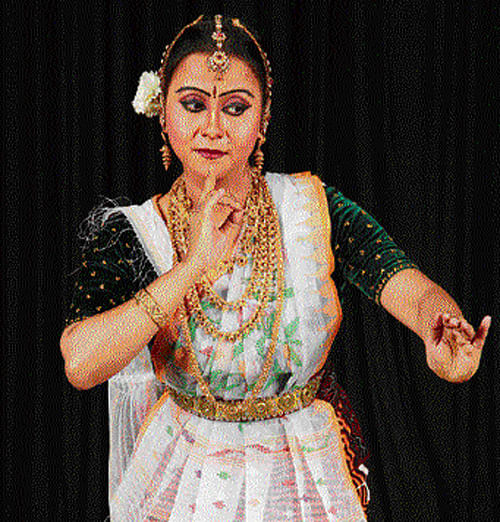
She might have been born and brought up in Kolkata, but Bimbavati Devi’s heart lies in Manipur. Young and extremely talented, taking Manipuri dance to new levels, Bimbavati Devi is the daughter of legends Guru Bipin Singh and Kalavati Devi.
“My father’s work is pioneering because he incorporated movements from Cholom (a style that is graceful and acrobatic at the same time) and drew greatly from the Shastras. He thus added a lot of colour to the dance form, while keeping the traditional aesthetics intact.” Bimbavati Devi is taking his gharana forward as a solo performing artiste of Manipuri Nartanalaya, one of the foremost institutions of Manipuri dance in India, which was founded in 1972 by her parents and the celebrated Jhaveri sisters.
“My father always believed that to be a Manipuri dancer, one should know how to play the Pung (traditional Manipuri hand-beaten drum).” It is not surprising, therefore, that Bimbavati has been groomed to play the Pung and that she has also undergone training in the basics of Thang Ta (Manipuri martial art). An excerpt from the website of Manipuri Nartanalaya reveals, “Never the one to be rigidly guided by the gender divide in Manipuri (dance), which reserves the softer Ras dances for the female performers, while male performers rendered the leaps and jumps and cart wheeling of the Cholom dances, he (Guru Bipin Singh) taught both types of movements to his female disciples. He also made the girls learn how to play the Pung...”
Taking baby steps
Speaking about her initiation into the world of dance and music, Bimbavati Devi says, “It’s almost like I could see the dance happening all around me even when I was in my mother’s womb!” Yet, she admits, she had a very simple upbringing, where dance was treated like an integral aspect of normal existence. And indeed, dance and music are an integral part of the Manipuri way of life, with roots in the religion of the land.
“My father used to pamper me,” Bimbavati Devi reminisces, “But my mother was strict about my classes and training. I am where I am today because of their blessings and the discipline that my mother imposed.” Guru Bipin Singh passed away in 2000, leaving a legacy behind him. Kalavati Devi is in her sixties and still going strong. She is one of the directors of Manipuri Nartanalaya and heads the department of Manipuri Dance at Rabindra Bharati University, Kolkata.
With numerous ballets and accolades to her credit, Bimbavati Devi has always tried to experiment with new idioms that expand the vocabulary of movement in Manipuri dance. At the moment, though, she claims, “I am going back to my roots, choreographing ballets very much Meitei in character; and concentrating on compositions by my father, on which not much work has been done.” Like her recent production Leichan (collection of flowers), staged at India International Centre, New Delhi. “It consisted of four different pieces based on the festival dances of Manipur. I have choreographed the pieces along with the rituals associated with the festivals. And the effort, again, has been to engage with the Meitei character.”
Her upcoming production has been titled Devatmayee (The Soul of the Gods), which, she tells me, “is rooted in the Aryan and non-Aryan aspects of Manipuri culture. It is about the ancient Manipuri concept of mother goddess, as contrasted with the mythological Vedic interpretation of the God Mother. It is about how her identification is a matter of speculation — both Vedic and archaic; and how her divinity is derived from the Puranas as well as the local folklores.” She is working on it with young Sanskrit scholar Srijan Chatterjee, who is also a Hindustani classical vocalist; and acclaimed musician N Tiken Singh has composed the music.
Bimbavati Devi says, “When one sees a performance, from top to bottom, it should look Manipuri. Be it the dress or the movements,” and emphasises that “one movement should merge with another, without a break. This is how this dance is different from all other classical dance forms.”
“Luckily,” she says of the place that is home, “in Kolkata, there is a lot of appreciation for Manipuri dance since Rabindranath Tagore was fond of this dance form, and brought it from the temple courtyards of Manipur to the outside world.” But with time, she feels that people are displaying set ideas about it, ignorant about the movements and essence it contains.
Bimbavati Devi closes the conversation with a sentiment that lingers, “Manipuri dance has its own identity. Awareness about its essence is missing. I am struggling to bring to people the grammar and possibilities within the dance form.”